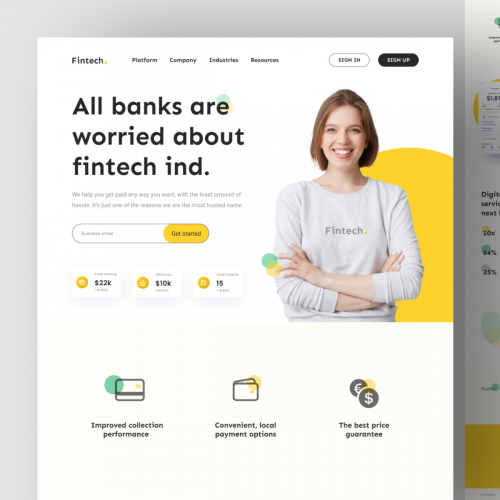Expert Website Design Services to Create Engaging and Functional Websites
Expert Website Design Services to Create Engaging and Functional Websites
Blog Article
Leading Tips for Developing an Impactful Website Style That Transforms
To attain this, one need to think about a variety of elements, including understanding the target audience, focusing on individual experience, and optimizing for mobile systems. The calculated usage of engaging call-to-actions and a well-defined aesthetic pecking order plays a crucial duty in guiding customers through their trip.

Understand Your Target Market
Understanding your target market is fundamental to effective internet site style, as it lays the groundwork for developing an appealing user experience. Recognizing who your customers are, including their demographics, choices, and habits, enables developers to tailor the internet site's content, format, and performance to fulfill specific demands.
Conducting extensive market research is critical in this process. Studies, interviews, and analytics can supply valuable insights into individual assumptions and pain factors. By assembling this data, developers can create user characters that represent various segments of the target market, guaranteeing that layout decisions are notified and pertinent.
Furthermore, comprehending the target market helps in choosing ideal design elements such as shade systems, typography, and imagery that resonate with customers. A site that talks straight to its target market promotes a sense of connection and depend on, motivating longer visits and greater conversion rates.
Inevitably, a user-centered approach to site style not just boosts individual fulfillment yet also supports service purposes by driving involvement and commitment. By focusing on the needs and preferences of the target audience, a website can efficiently serve its function and accomplish preferred results.
Prioritize Individual Experience
To improve the total performance of a site, focusing on customer experience (UX) is vital (Website Design). A properly designed UX makes sure that site visitors can navigate the site effortlessly, find details promptly, and involve with material meaningfully. This causes boosted individual fulfillment and greater conversion prices
Begin by executing intuitive navigating. Menus ought to be practically structured, enabling individuals to locate key locations of the website with marginal effort. Consistency in layout aspects, such as shade systems and font styles, fosters knowledge, which is critical for keeping individual engagement.
In addition, think about the packing speed of your website. A hold-up of just a couple of secs can lead to substantial drop-offs, as individuals are less likely to wait on a slow-loading page. Streamlining pictures and optimizing code can boost performance and preserve visitors.
Additionally, clarity in content discussion is essential. Use succinct, interesting language and break up text with visuals to enhance readability. By focusing on user experience, you not just create a much more delightful environment for visitors however additionally strengthen your brand's reputation. Ultimately, a focus on UX is a financial investment in the lasting success of your web site.
Optimize for Mobile Gadgets
Enhancing for smart phones is crucial in today's electronic landscape, where a boosting number of users access websites through smartphones and tablets. A mobile-friendly layout not only boosts customer experience yet additionally plays a substantial duty in enhancing internet search engine positions. To accomplish this, it is important to take on a receptive style that immediately adjusts to various display dimensions and positionings.

Filling rate is another important factor; mobile individuals are commonly less individual and anticipate fast accessibility to details. By prioritizing mobile optimization, you make certain that your site stays affordable and effectively engages a wider target market.
Usage Compelling Call-to-Actions
A site's visit this page efficiency commonly rests on its capacity to assist visitors toward preferred actions, making engaging call-to-actions (CTAs) crucial components of layout. CTAs work as the critical factors that route customers to involve with the site, whether that means buying, registering for an e-newsletter, or downloading a source.
To create effective CTAs, quality is paramount. Usage succinct language that plainly interacts the action you desire the individual to take. Expressions such as "Begin," "Authorize Up Free," or "Store Now" not just share necessity yet additionally eliminate obscurity. The positioning of CTAs is similarly important; they need to be purposefully placed throughout the page to guarantee they are quickly noticeable, particularly in high-traffic areas.
In addition, the design of CTAs should stand out without being meddlesome. Utilize contrasting shades and clear font styles to ensure they record focus. Furthermore, consider utilizing directional cues, such as arrows or images, to lead individuals toward these buttons. By concentrating on these elements, businesses can considerably boost customer interaction, driving conversions and eventually achieving their web site's objectives.
Focus on Visual Pecking Order
Effective internet site layout relies greatly on a well-structured aesthetic pecking order that guides customers via material seamlessly. By arranging elements in a way that focuses on information, designers can enhance individual experience and facilitate decision-making. This includes making use of dimension, shade, contrast, and spacing tactically to accentuate one of the most essential components of a web page.
Making use of larger font styles for headings and subheadings develops a clear difference in between different sections, enabling customers to check content effortlessly. Furthermore, using different shades for buttons and calls-to-action can capture customer attention and encourage interaction. Whitespace is one more crucial component; it avoids clutter and allows customers to focus on crucial messages without disturbances.
Pictures and graphics must enhance the text while also adhering to the recognized pecking order, strengthening the overall message (Website Design). Consistency in style aspects, such as color design and typography, more reinforces the aesthetic power structure, making navigation instinctive

Conclusion
In conclusion, reliable internet web site design requires an extensive understanding of the target audience, prioritization of customer experience, and mobile optimization. Eventually, a well-executed website style serves as an important component in driving customer actions and accomplishing organization goals.
Report this page